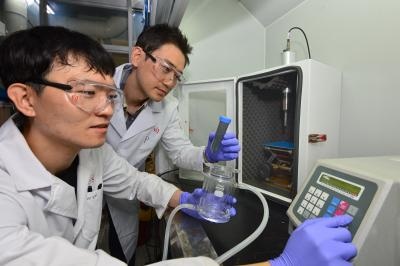Jul 22 2019
The advanced environmentally friendly, low-cost, and high-efficiency wastewater processing catalyst produced from agricultural by-product, together with the high efficiency and removal rate realized through the application of ultrasound stimulation, resulted in high expectation for the development of a new environmental hormone removal system.
 The photograph of researchers. (Image credit: Korea Institute of Science and Technology (KIST))
The photograph of researchers. (Image credit: Korea Institute of Science and Technology (KIST))
The team of scientists, including Dr Jae-woo Choi and Dr Kyung-won Jung of the Korea Institute of Science and Technology’s (KIST, president: Byung-gwon Lee) Water Cycle Research Center, announced that it has created a wastewater treatment process that utilizes a common agricultural by-product to efficiently eliminate pollutants and environmental hormones, which have been shown to be endocrine disruptors.
Both wastewater and sewage that are unavoidably formed at any industrial worksite usually consist of huge quantities of environmental hormones (endocrine disruptors) and pollutants. Since environmental hormones do not disintegrate easily, they can have a massive adverse impact on the environment as well as on the human body. A method of removing environmental hormones is needed to stop this.
Over time, the performance of the existing catalyst being used to process wastewater and sewage declines considerably. As it is not easy to realize high efficiency under the given conditions, the biggest drawback of the current process is the high cost involved.
Moreover, the study carried out so far has mainly concentrated on the development of single-substance catalysts and the improvement of their performance. Not much research has been carried out on the development of environmentally friendly nanocomposite catalysts that can eliminate environmental hormones from wastewater and sewage.
The group of scientists at KIST, headed by Dr Jae-woo Choi and Dr Kyung-won Jung, employed biochar, which is environmentally friendly and developed from agricultural by-products, to design a wastewater treatment process that efficiently eliminates environmental hormones and pollutants.
Biochar is a term that collectively refers to substances that can be produced through the thermal decomposition of various types of biomass or wood under oxygen-limited conditions.
The group employed rice hulls, which are thrown away at the time of rice harvesting, to produce a biochar that is not only environmentally friendly but also economical. Nano-sized manganese dioxide was applied to the surface of the biochar to produce a nanocomposite. The low cost and high efficiency of the biochar-nanocomposite catalyst are based on the combination of the benefits of the manganese dioxide and biochar.
The research group at KIST employed the hydrothermal technique, which is a kind of mineral synthesis that utilizes high heat and pressure when producing the nanocomposite to develop a catalyst that is easily replicable, highly active, and stable.
It was demonstrated that when a three-dimensional stratified structure is given to the catalyst, the advanced oxidation process (AOP) becomes highly effective because of the large surface area formed.
When employed under the same conditions in which the currently used catalyst can eliminate only 80% of Bisphenol A (BPA)—an environmental hormone—the catalyst created by the KIST group eliminated more than 95% in less than one hour.
Particularly, when integrated with ultrasound (20 kHz), it was proved that all traces of BPA were fully removed in less than 20 minutes. Even after several repeated tests, the BPA removal rate remained consistently at about 93%.
The catalyst developed through this study makes use of a common agricultural byproduct. Therefore, we expect that additional research on alternative substances will lead to the development of catalysts derived from various types of organic waste biomass.
Dr Kyung-won Jung, Water Cycle Research Center, KIST
Dr Jae-woo Choi, also of KIST’s Water Cycle Research Center, stated, “We have high hopes that future studies aimed at achieving process optimization and increasing removal rates will allow for the development an environmental hormone removal system that is both eco-friendly and low-cost.”